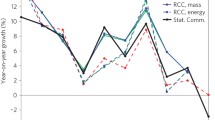Abstract
According to official Chinese statistics, sulfur dioxide emissions dropped significantly in the late 1990s before rising again. Some researchers have expressed concern over data reliability, however, and the sample of enterprises represented by sulfur dioxide emission statistics generates only one third of China’s industrial output, which may result in undercounting of emissions. In addition, coal production and consumption during the late 1990s may have been undercounted due to politically motivated manipulation of numbers, and this phenomenon may also partly explain the reported reductions in sulfur dioxide emissions. Coal sulfur content derived from coal supply-side information is generally found to be higher than from demand-side information used to calculate emissions for official statistics. Meanwhile, no solid data are available that demonstrate improvement of the desulfurization of smokestack emissions. All of these are potential factors in the underestimation of China’s emissions.
Similar content being viewed by others
References
Carmichael GR, Streets DG, Calori G, Amann M, Jacobson MZ, Hansen J, Ueda H (2002) Changing trends in sulfur emissions in Asia: implications for acid deposition, air pollution, and climate. Environmental Science and Technology 36:4707–4713
Chen P (2001) Property and classification of Chinese coal and its utilization (in Chinese). Chemical Industry Press, Beijing
China Environment Daily (1999) It is necessary to identify sources to control sulfur dioxide emissions, China Environment Daily, 3 September 1999 http://www.cenews.com.cn/news/1999-11-06/923.php (in Chinese). Cited 25 April 2006
China Environment Yearbook Committee (eds) (1991–2003). China Environment Yearbook, China Environment Yearbook Press, Beijing
China Internet Information Center (2003) Output of environmental protection industry in China reached 220 billion yuan. http://www.china.org.cn/chinese/EC-c/258185.htm (in Chinese). Cited 2 October 2005
Compiling Committee of China Coal Industry Yearbook (eds) (1981–2003) China Coal Industry Yearbook, Coal Industry Press, Beijing
Department of Industry and Transportation Statistics, National Bureau of Statistics (eds) (1997–2001) China Energy Statistical Yearbook, China Statistics Press, Beijing
Department of Industry and Transportation Statistics, National Bureau of Statistics (eds) (2002) China Industry Economy Statistical Yearbook, China Statistics Press, Beijing
Fisher-Vanden K, Jefferson GH, Liu H, Tao Q (2002) What is driving China’s decline in energy intensity? Book of Abstracts, 2nd World Congress of Environmental and Resource Economists 82
Fujita M, Hu D (2001) Regional disparity in China 1985–1994: the effects of globalization and economic liberalization. The Annals of Regional Science 35:3–37
Horii N (2003a) Factors hindering market unification of coal industry in China (in Japanese). Institute of Developing Economies 44:2–37
Horii N (2003b) Issues of coal quality control as a pollution control measures in China (in Japanese). In: Terao T, Otsuka K (eds) Reevaluation of environmental policies in the Asia (in Japanese). Institute of Developing Economies, Chiba, pp 49–83
Horii N (2005) Assessment of air pollution control policy in China (in Japanese). In: Terao T, Otsuka K (eds) Environmental policy and social changes in Asia. Institute of Developing Economies, Chiba, pp 23–67
Japan Center for International Finance (2004) Various problems that have emerged under the new economic structure in China (in Japanese). Japan Center for International Finance, Tokyo
Lewis JI, Fridly DG, Sinton JE, Lin J (2003) Sectoral and geographic analysis of the decline in China’s national energy consumption in the late 1990s. Proceedings of the ACEEE Summer Study on Energy Efficiency in Industry, July 29–August 1, 2003, Rye Book, New York
National Bureau of Statistics of China (1999) Comprehensive statistical data and materials on 50 years of new China. China Statistics Press, Beijing
Otsuka K (2002) Implementation process of regulations for point sources of industrial pollutants in China (in Japanese). In: Terao T, Otsuka K (eds) Dynamism of the policy process in “development and environment”. Institute of Developing Economies, Chiba, pp 139–185
Rawski TG (2001) What is happening to China’s GDP statistics? China Economic Review 12:347–354
Sagawa A, Fukushima A, Mimuroto Y, Chew CS (2003) Perspectives on coal demand and supply in China and its transportation (in Japanese). Enerugi Keizai http://eneken.ieej.or.jp/data/pdf/690.pdf Cited 2 October 2005
Scharping T (2001) Hide-and-seek: China’s elusive population data. China Economic Review 12:323–332
Sinton JE (2001) Accuracy and reliability of China’s energy statistics. China Economic Review 12:373–383
State Environmental Protection Administration (SEPA) (eds) (1990–2004) Annual report on the state of the environment in China (in Chinese). http://www.zhb.gov.cn/eic/649368268829622272/index.shtml Cited 20ctober 2005
SEPA (eds) (1998–2002) Annual report on environmental statistics of China. State Environmental Protection Administration, Beijing
State Statistical Bureau (eds) (1993–2002) China Statistical Yearbook, P. R. China, China Statistics Press, Beijing
Streets DG, Waldhoff ST (2000) Present and future emissions of air pollutants in China: S02, NOX and CO. Atmospheric Environment 34:363–374
Streets DG, Tsai NY, Akimoto H, Oka K (2000) Sulfur dioxide emissions in Asia in the period 1985–1997. Atmospheric Environment 34:4413–4424
Taketoshi K (2001) Environmental pollution and policies in China’s township and village industrial enterprises. Discussion paper on Center for Development Research No. 36, University of Bonn, Bonn
Wang X, Meng L (2001) A reevaluation of China’s economic growth. China Economic Review 12:338–346
Wu L, Kaneko S, Matsuoka S (2005) Driving forces behind the stagnancy of China’s energy-related CO2 emissions from 1996 to 1999: the relative importance of structural change, intensity change and scale change. Energy Policy 33:319–335
Xu X (1997) Combustion management: energy consumption, pollution, and combustion management in China (in Japanese). In: Sadakata M (ed) China Environmental Handbook. Science Forum, Tokyo, pp 185–189
Yearbook of China Transportation and Communications Editing Committee (eds) (1997–2001) Yearbook of China transportation and communications. Yearbook House of China Transportation and Communications, Beijing
Author information
Authors and Affiliations
About this article
Cite this article
Fujikura, R., Kaneko, S., Nakayama, H. et al. Coverage and reliability of Chinese statistics regarding sulfur dioxide emissions during the late 1990s. Environ Econ Policy Stud 7, 415–434 (2006). https://doi.org/10.1007/BF03353949
Received:
Accepted:
Published:
Issue Date:
DOI: https://doi.org/10.1007/BF03353949




